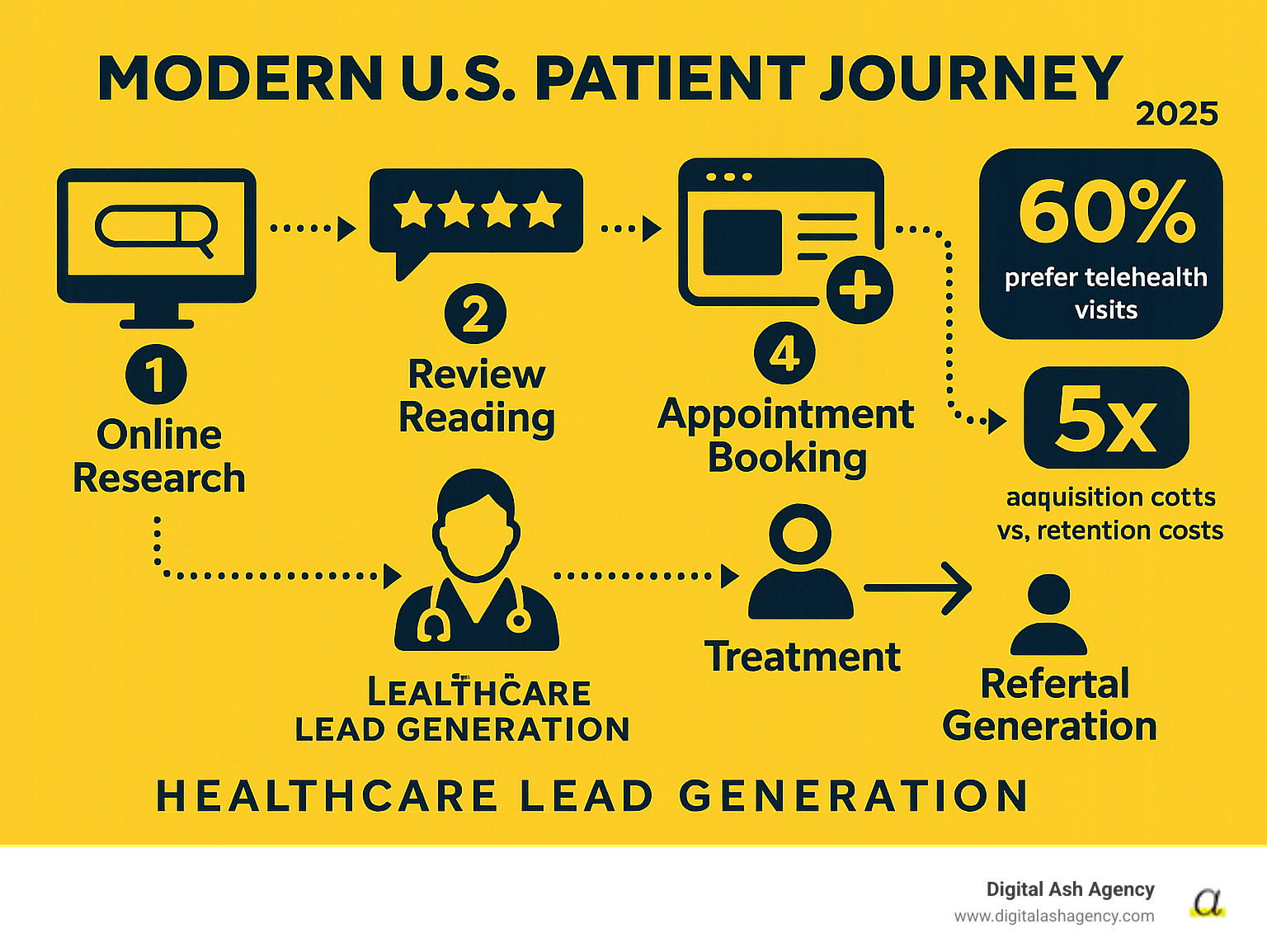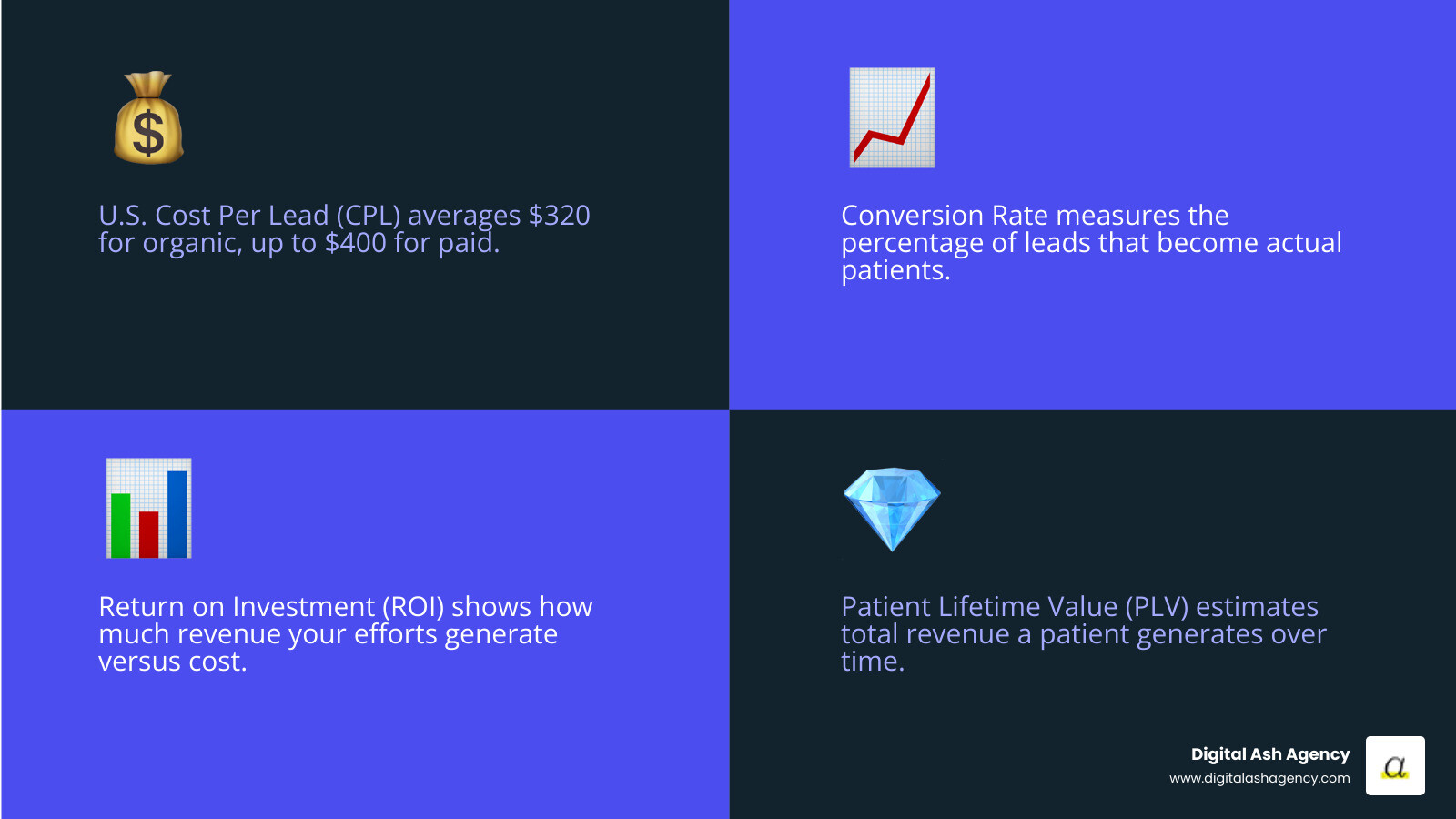
Why Healthcare Lead Generation is Critical for Modern Practice Success
Healthcare lead generation is the process of attracting and converting potential patients into appointments. With 60% of U.S. consumers preferring telehealth and intense competition, a systematic approach to patient acquisition is critical.
Quick Answer: The 6 Essential Healthcare Lead Generation Strategies:
- Create an Ideal Patient Profile (IPP) - Define your perfect patient demographics and pain points
- Build a High-Converting Website - Optimize for mobile, speed, and clear calls-to-action
- Leverage SEO and Content Marketing - Attract patients through valuable, expert content
- Use Paid Advertising - Amplify reach with targeted Google Ads and social media campaigns
- Implement Email Nurturing and CRM - Build relationships through HIPAA-compliant communication
- Systematize Patient Referrals - Turn satisfied patients into your best marketing channel
The healthcare landscape has shifted. Traditional marketing is obsolete. Today's patients research providers online, read reviews, and expect seamless digital experiences before booking.
The data is clear: acquiring new patients costs five times more than retaining existing ones. Increasing patient retention by just 5% can boost profits by up to 95%. Your strategy must focus on both attracting quality leads and nurturing long-term relationships.
Modern practices face unique challenges like HIPAA compliance, non-compete agreements, and highly selective patients.
I'm Ashley Gay, and I've helped practices steer these challenges, including building my husband's practice which billed $239K in its first 90 days despite non-compete restrictions. Success in healthcare lead generation requires a blend of digital marketing expertise and a deep understanding of healthcare regulations.

Understanding the Core Challenges in Healthcare Lead Generation
Healthcare lead generation is the top marketing priority for over a third of U.S. providers. It's about building a sustainable practice in an increasingly complex landscape.
Building patient trust is the biggest hurdle. Patients are placing their health in your hands, so they spend hours researching credentials, reading reviews, and seeking recommendations before making contact.
U.S. healthcare market competition is fierce. You're competing with established practices, hospitals, and telehealth platforms. Standing out requires a clear, compelling message that resonates with your ideal patients.
Navigating U.S. healthcare regulations is complex. HIPAA compliance is mandatory, and state requirements vary. All marketing communications must meet strict standards to avoid hefty fines.
Proving ROI is a major pain point. Many practices spend money on marketing without clear visibility into what's working, unsure if their campaigns are actually bringing in new patients.
HIPAA compliance affects every aspect of lead generation. How you collect and use information on website forms and in follow-ups must be designed to protect patient data. It's the law.
Finally, finding good leads affordably is a challenge. The average U.S. healthcare lead costs $320 (organic) to $400 (paid). The actual cost to acquire a patient can be substantial, making it crucial to find the right leads.
These challenges explain why a strategic approach to healthcare lead generation is essential for your practice's long-term success. The good news is that each of these challenges has a solution.
Foundational Strategies: Define Your Audience and Build Your Digital Hub

Your digital presence is your modern, 24/7 waiting room. Today's patients find you on their smartphones, researching providers whenever and wherever is convenient.
This digital-first approach is crucial. Your online presence determines if a patient chooses you or a competitor. It's about building a trustworthy online brand that inspires confidence.
The foundation requires two steps: defining your audience and building a welcoming digital hub. Get these right, and everything else becomes easier. For more on this, see our guide on Branding for Doctors.
Strategy 1: Create an Ideal Patient Profile (IPP)
Marketing to everyone is ineffective. An Ideal Patient Profile (IPP) is a detailed portrait of your perfect patient, built from data and insights about who benefits most from your services.
Your IPP should include demographics (age, income) and geographics (where patients live, travel distance). Dig into patient pain points—their health concerns, frustrations, and daily struggles. This helps you position your practice as the solution. Also, understand their motivations. Do they value convenience, thorough consultations, or cutting-edge technology?
Use internal data from your current patient base—common questions, scheduling patterns, and feedback—to build your IPP. This is a goldmine for effective healthcare lead generation.
A clear IPP makes your marketing laser-focused, allowing you to speak directly to patient needs. This targeted approach is highly effective, as seen with practices that Attract New Dermatology Patients by defining their profiles.
Strategy 2: Build a Professional, High-Converting Website
Your website is your hardest-working team member, converting visitors into patients 24/7. To be effective, it must be designed for both user experience and conversion.
- Mobile-friendliness is mandatory. Most patients will find you on their phones. A poor mobile experience means they'll leave for a competitor's site instantly.
- Fast loading speeds are crucial. A site that takes more than a few seconds to load will lose potential patients and revenue.
- Clear calls-to-action (CTAs) on every page should guide visitors to the next step, like calling your office or scheduling online.
- Online appointment scheduling is a game-changer. Patients love the 24/7 convenience of booking appointments themselves.
- Managing online reviews is powerful. Positive reviews are digital word-of-mouth, and responding professionally to all feedback shows you care.
Your website is the central hub for all healthcare lead generation efforts. It's where prospects land before booking an appointment. We help practices build these powerful platforms with our Solutions for Healthcare providers.
Inbound Marketing Strategies for Attracting New Patients

Inbound marketing turns your practice into a magnet, attracting the right patients by providing valuable information they're already searching for, rather than interrupting them with ads.
This approach is ideal for healthcare, where trust is paramount. By creating valuable content for your Ideal Patient Profile, you become a trusted resource, which naturally leads to more meaningful patient relationships. This patient-centered approach makes patients feel like they've found a solution, not that they're being marketed to. Our guide on Digital Marketing for Doctors offers deeper insights.
Strategy 3: Leverage SEO and Content Marketing for Healthcare Lead Generation
SEO and content marketing ensure your practice appears when potential patients search for help. Creating valuable content is key. Create blog posts, patient guides, and videos that answer the real questions your patients ask.
Focus on E-E-A-T (Expertise, Experience, Authoritativeness, Trustworthiness). Google prioritizes these factors for health content. As a professional, you have the expertise; your content must showcase it with accurate information and clear credentials.
Local SEO is your secret weapon for attracting nearby patients. Claim and optimize your Google Business Profile with current hours, services, photos, and reviews to appear in searches like "pediatrician near me." Identify and use the search terms your patients use, such as "knee pain doctor" instead of "orthopedic surgeon."
This approach to search engine optimization (SEO) builds trust and creates a steady stream of qualified leads.
Strategy 4: Use Paid Advertising to Amplify Your Reach
While SEO builds long-term growth, paid advertising offers immediate, targeted visibility to patients actively seeking your services.
Pay-per-click (PPC) ads on platforms like Google Ads place you at the top of search results. You only pay when someone clicks, and U.S. businesses report earning $2 for every $1 spent, making it a reliable investment.
Social media ads on Facebook and Instagram allow for precise targeting of specific demographics. You can reach parents with young children for a pediatric practice or adults over 50 for joint replacement services.
Retargeting website visitors keeps your practice top-of-mind for those who have shown interest but haven't converted. It shows your ads to previous visitors as they browse other sites.
Budgeting for ads strategically is about efficiency, not high spending. Focus on campaigns with the strongest ROI, constantly testing and refining to maximize every dollar. Thoughtful paid advertising is a powerful amplifier for healthcare lead generation. For inspiration, see our Healthcare Advertising Ideas.
Conversion and Retention Strategies: Nurture and Multiply Your Leads

Attracting leads is just the first step in healthcare lead generation. The real goal is converting interested visitors into loyal patients who advocate for your practice.
The data is compelling: increasing patient retention by just 5% can raise profits by up to 95%. Focusing on nurturing relationships makes your practice more profitable and improves patient care. Patient retention means building trust so that patients actively recommend you. Learn more in our guide on Patient Engagement Methods.
Strategy 5: Implement Email Nurturing and a Healthcare CRM
When a potential patient shows interest, a nurturing system is crucial to prevent the lead from going cold. Building relationships via email requires a soft touch. Your first email should be a warm welcome that delivers value, with subsequent emails building trust.
Segmenting your email lists is critical for effectiveness. Speaking directly to a patient's specific situation makes your message far more resonant. Automated campaigns work 24/7, sending educational emails to guide leads toward booking an appointment.
HIPAA-compliant communication is the foundation of all patient outreach. All platforms and data handling must be secure. Centralizing patient data with a healthcare CRM provides a clear picture of every patient interaction, helping track marketing effectiveness and automate follow-ups.
This systematic approach makes healthcare lead generation a predictable process.
Strategy 6: Systematize Patient Referrals and Word-of-Mouth
Referrals and word-of-mouth are the most powerful lead generation tools in the U.S. healthcare market. Most practices leave referrals to chance; instead, you should make them a systematic part of your growth strategy.
- Create a referral program. Make it easy for satisfied patients to share their positive experiences.
- Ask for reviews. This helps future patients make informed decisions. Most happy patients are willing to share.
- Use patient satisfaction surveys. These help you improve care and identify your most enthusiastic patients.
- Train your staff. Teach them to naturally incorporate referral requests into genuine conversations.
By systematizing referrals, you turn your patient base into a powerful healthcare lead generation engine, attracting the right kind of new patients through authentic enthusiasm.
Measuring Success: Tracking ROI on Your Lead Generation Efforts
A key advantage of modern healthcare lead generation is that nearly everything is measurable. This allows for smart, data-driven decisions that protect your budget and fuel growth.
Just as you monitor vital signs during surgery, you must track your marketing. Without data, you're guessing which strategies work and which are wasting money. Metrics transform hope into knowledge, showing you exactly what drives results. This data-driven approach is a fundamental part of any effective Business Plan Healthcare strategy.
Key Metrics for Your Healthcare Lead Generation
Track these essential metrics to evaluate your healthcare lead generation success and understand the full patient acquisition journey:
- Lead Volume: The total number of potential patients. Quality is more important than quantity.
- Cost Per Lead (CPL): Measures marketing efficiency (total cost / leads). A CPL of $80 is excellent compared to U.S. averages of $320-$400.
- Conversion Rate: The percentage of leads who become patients. A high rate indicates you're attracting the right people.
- Cost Per Acquisition (CPA): Your most important metric. It's the total cost to gain one new patient and directly impacts profitability.
- Return on Investment (ROI): Shows if your marketing is profitable. Positive ROI is good; negative ROI means you need to adjust.
- Patient Lifetime Value (PLV): The total estimated revenue a patient will generate over time. It helps justify acquisition costs for long-term patients.

Consistent monitoring of these metrics allows for real-time fine-tuning of your healthcare lead generation strategies. We can double down on what works and pivot from what doesn't, ensuring every marketing dollar is a smart investment.
Frequently Asked Questions about Generating Healthcare Leads
Here are answers to the most common questions we receive about patient acquisition and healthcare lead generation.
How do I ensure my marketing is HIPAA compliant?
HIPAA compliance is the foundation of ethical marketing. A slip-up can lead to large fines and damage patient trust. Key steps include:
- Understand Protected Health Information (PHI). This includes names, records, and even appointment times linked to an individual. Never use unsecured channels for PHI.
- Use secure forms on your website and encrypted email for any communication containing PHI.
- Select a HIPAA-compliant CRM designed for healthcare. Your vendor must sign a Business Associate Agreement (BAA).
- Conduct regular staff training. Everyone on your team must understand their role in maintaining HIPAA compliance.
How much should a healthcare practice budget for marketing?
There's no single magic number, but here are some solid U.S. industry guidelines:
- Established practices: Budget 5-10% of gross revenue.
- New or competitive-market practices: Budget 10-15% or more initially.
Your growth stage and the competitive landscape also dictate budget needs. The most important factor is tracking ROI to justify your spend. A campaign that returns $5 for every $1 invested is worth expanding. For more on financial planning, see our resource on Starting a Private Practice.
What are the key criteria for selecting a healthcare lead generation agency?
Choosing the right partner is crucial. Look for an agency that understands the unique challenges of healthcare marketing.
- Industry experience: The agency must understand patient psychology and the trust-building process. Ask for examples of healthcare practices they've helped.
- Understanding of HIPAA: This is non-negotiable. The agency must detail their compliance measures and provide a signed BAA.
- Case studies and testimonials: Look for proven results from practices in your specialty, with specific metrics like CPA, conversion rates, and ROI.
- Transparent reporting: Demand regular reports that show real results like patient acquisitions, not just vanity metrics.
- Strategic partnership: Choose a partner, not a vendor. They should invest time to understand your unique goals. Learn What Makes Digital Ash Different in our approach.
Grow Your Practice with a Strategic Approach
The journey through healthcare lead generation is manageable with the right strategies. These six approaches can transform how your practice attracts and retains patients in the competitive U.S. market.
These strategies are building blocks for sustainable growth. Defining your IPP creates a roadmap, a high-converting website acts as your 24/7 digital office, and SEO and content marketing establish you as a trusted expert. Paid advertising amplifies your reach, email nurturing builds lasting relationships, and systematized referrals turn your happiest patients into your best marketing channel.
Together, these strategies create long-term growth and a significant competitive advantage. They help you build genuine relationships with patients who trust you and advocate for your practice.
We understand the unique challenges of healthcare, from intense competition to complex regulations and non-compete restrictions. These proven methods will help your practice thrive.
As the landscape evolves, practices that invest in strategic, relationship-focused healthcare lead generation will succeed. This approach creates a sustainable system that builds a reputation and makes your practice the obvious choice.
Ready to put these strategies into action? To build a thriving practice, explore our solutions for Established Practices. Let's create a marketing system that fills your schedule with the right patients.







